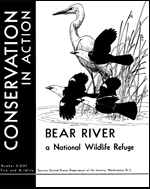United States Fish and Wildlife Service

United States Fish and Wildlife Service: Publications
Date of this Version
2000
Abstract
A review of the recent literature and research in progress on bird collisions with
communication towers was contracted by the U. S. Fish and Wildlife Service. In the five year period 1995 through 1999, very little research was published or conducted that is relevant to the bird-communication tower collision problem. It seems that since the major reviews of the late 1970s and early 1980s, few researchers and others have been interested in researching the problem. Before 1985, there was an enormous body of literature, mostly anecdotal that has not been examined analytically.
For the current review,, a standard literature search was conducted along with a search of the world wide web. In addition, all state fish and game agencies (nongame programs), state ornithological organizations (and their publication editors), bird observatories and organizations, and listserves were canvassed via email, as were representatives of conservation organizations of more than 25 countries. Finally, about a dozen of the world's leading researchers on the topic were interviewed to determine whether they were conducting research or whether they knew of anyone who was. Questionnaires were designed and tailored to each of the groups canvassed.
Although there is little research now being conducted or results published within the past five years, several researchers are now conducting studies of towerkills in Kansas, West Virginia, and New York. These studies, in addition to studies of towerkills at recently developed wind turbine sites, suggest that shorter towers do not kill as many birds as taller towers (no major mortality events have been reported at the shorter towers), although this conclusion should not be considered definitive.
With respect to research on the influence of magnetic radiation and radio frequencies in the range of those emanating from towers on migrating birds, there is little research. Experts canvassed did not feel that these waves are as strong as the earth's magnetic field and are not likely to cause disruption of night migrating birds' orientation or navigation systems. One potentially promising technique involves the impacts of infrasonic (low-frequency acoustic) shock waves on birds, particularly Homing Pigeons, which may – following research into its efficacy – provide a means for warning birds of tower presence and resultant bird avoidance, even in inclement weather.
There have been no studies documenting the difference in risk of various lighting systems, although several researchers stated that white strobes are likely to be less risky than white or red blinking lights.


Comments
Published by Curry & Kerlinger, L.L.C., 1-38, (2000)